|
|
|
Sort Order |
|
|
|
Items / Page
|
|
|
|
|
|
|
| Srl | Item |
| 1 |
ID:
128862
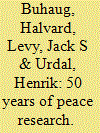

|
|
|
|
|
| Publication |
2014.
|
| Summary/Abstract |
Established in 1964, the Journal of Peace Research (JPR) celebrates 50 years. This anniversary special issue of the journal offers broad reviews of research areas that have been central both to the journal and to the field of peace and conflict research generally. An opening article co-authored by long-time editor Nils Petter Gleditsch offers a historical view on peace research and tracks trends in the use of 'peace' and 'violence' in titles of JPR across the first 49 volumes of the journal. Opening the review article section, two contributions address key thematic areas for the journal. Few if any subjects have attracted more attention in the study of international relations during the second half of JPR's first 50 years than the democratic peace, and in the extension of this subject, the broader debate about the liberal peace. Additional articles review the status and propose future developments in the study of war and its relationship with territory, ethnicity, ideology and natural resources. Another key historical topic associated with the journal concerns the economic cost of military conflict, while more recent research fields covered include terrorism and human rights, topics that have grown to become major JPR niches. Reflecting the methodological contributions by JPR, two articles focus on challenges of contemporary quantitative political analysis and progress in peace and conflict data collection. Finally, this special issue includes a review of research on international mediation in armed conflicts.
|
|
|
|
|
|
|
|
|
|
|
|
|
|
|
|
| 2 |
ID:
126015


|
|
|
|
|
| Publication |
2013.
|
| Summary/Abstract |
Before the 1990s, very little research had been done on the religious dimension in the dynamics of internal and international violent conflicts. Two factors may explain this: first, the lack of interest of a good part of international theory in peace research and conflict resolution in particular; and, second, the negative impact of the division between the major disciplines of social sciences and area studies. This article takes this insufficiency as its starting point and assumes that the factors of greatest value in explaining violent conflict are diverse (political, economic or social processes), and to speak of a single factor (religion) in isolation makes little sense if it is not contextualized within a metatheory. Thus, the article presents several elements that are derived from the theory of conflict resolution and area studies on the Middle East and North Africa region, and which should be taken into consideration when examining the extent to which religion contributes to violent conflicts and their evolution.
|
|
|
|
|
|
|
|
|
|
|
|
|
|
|
|
| 3 |
ID:
099721
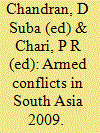

|
|
|
|
|
| Publication |
New Delhi, Routledge, 2010.
|
| Description |
xiii, 240p.
|
| Standard Number |
9780415564441
|
|
|
|
|
|
|
|
|
|
|
|
Copies: C:1/I:0,R:0,Q:0
Circulation
| Accession# | Call# | Current Location | Status | Policy | Location |
| 055381 | 355.0218054/CHA 055381 | Main | On Shelf | General | |
|
|
|
|
| 4 |
ID:
104838
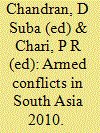

|
|
|
|
|
| Publication |
New Delhi, Routledge, 2011.
|
| Description |
xi, 233p.
|
| Standard Number |
9780415612562, hbk
|
|
|
|
|
|
|
|
|
|
|
|
Copies: C:1/I:0,R:0,Q:0
Circulation
| Accession# | Call# | Current Location | Status | Policy | Location |
| 056108 | 303.6405/CHA 056108 | Main | On Shelf | General | |
|
|
|
|
| 5 |
ID:
114517


|
|
|
|
|
| Publication |
New Delhi, Routledge, 2012.
|
| Description |
xxi, 297p.Hbk
|
| Standard Number |
9780415529631
|
|
|
|
|
|
|
|
|
|
|
|
Copies: C:1/I:0,R:0,Q:0
Circulation
| Accession# | Call# | Current Location | Status | Policy | Location |
| 056780 | 303.6405/CHA 056780 | Main | On Shelf | General | |
|
|
|
|
| 6 |
ID:
139351
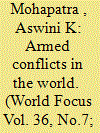

|
|
|
|
|
| Summary/Abstract |
To sum up, what accounts for the rising incidence of internal armed conflicts in plural societies is the interplay of variety of factors ranging from the nature of the polity (i.e. liberal/transitional democratic or autocratic), stage of economic development, level of integration and state-society engagement to the process of state formation and national identity construction.
|
|
|
|
|
|
|
|
|
|
|
|
|
|
|
|
| 7 |
ID:
133711
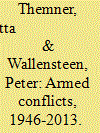

|
|
|
|
|
| Publication |
2014.
|
| Summary/Abstract |
In 2013, the Uppsala Conflict Data Program (UCDP) recorded 33 armed conflicts with a minimum of 25 battle-related deaths, up by one from 2012. Seven of these were recorded as wars, that is conflicts leading to 1,000 or more battle-related deaths in a calendar year. There have been 144 armed conflicts (47 wars) since 1989 and 254 armed conflicts (114 wars) since 1946. For the past ten years the amount of active armed conflict has fluctuated between 31 and 37. Six peace agreements were signed during the year 2013, two more than in the previous year. For the first time, this article also provides data on trends in battle-related deaths since 1989. These data do not show a clear time-trend. However, there is a particular difficulty in mapping the conflict in Syria, for which no credible battle-related deaths in 2013 can yet be reported.
|
|
|
|
|
|
|
|
|
|
|
|
|
|
|
|
| 8 |
ID:
074283
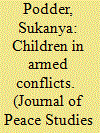

|
|
|
| 9 |
ID:
133474
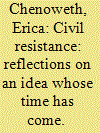

|
|
|
|
|
| Publication |
2014.
|
| Summary/Abstract |
IT HAS BEEN THREE YEARS SINCE WHY CIVIL RESISTANCE WORKS HIT THE shelves.1 When Maria J. Stephan and I sent the final galleys into the publisher, we had no idea that the Arab Spring was about to grip the world; that the Occupy movement would reenergize the protest sector in advanced
democracies; or that countries as diverse as Turkey, Venezuela, Ukraine, Thailand, and India would be rocked by nonviolent resistance against entrenched authority, lack of economic opportunity, and corruption. While many people have cataloged the global decline in armed conflict, few have noticed that, in the meantime, the use of civil resistance has been on the rise.
|
|
|
|
|
|
|
|
|
|
|
|
|
|
|
|
| 10 |
ID:
130810
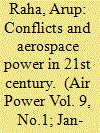

|
|
|
| 11 |
ID:
146278
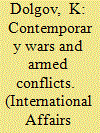

|
|
|
|
|
| Summary/Abstract |
ALL GREATEST LITERARY CREATIONS of antiquity, be it the Mahabharata, the Bible, the Iliad and the Odyssey, the Avesta, the Kalevala and others tell us about conflicts, confrontations, struggle, and wars as the most important events in the history of mankind. This creates an impression that at all times people knew no other occupations but wars or preparations for new wars once the previous war was over and that mankind appeared on Earth and lived on it to fight and to destroy itself. Progress was and is limited to consistent upgrade of the old and invention of new types of deadly weapons rather than develop personality, its abilities, talents, and spirituality.
|
|
|
|
|
|
|
|
|
|
|
|
|
|
|
|
| 12 |
ID:
180692
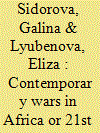

|
|
|
|
|
| Summary/Abstract |
Lately the African continent has been the focus of global attention and discussions on the present and future of Africa, especially with regards to the highly topical questions concerning the global and African state of peace and security. As multiple extremely complex armed conflicts continue to cause chronic instability and vulnerabilities in several African states and regions, they also directly affect the state of international security in the 21st century in an intensively interconnected and globalized world from an economic, political and peace/security perspective. Accordingly, this research article offers an in-depth analysis of some of the major causes and explanations of the existing wars in Africa related to the illicit exploitation of resources, vulnerability, and control. The goal of this work is to reveal and analyze the complexity of 21st-century wars in Africa and their deep interrelated causes by applying the example of the long and banal armed conflicts in the Democratic Republic of the Congo. Thus, the authors argue that the destabilization of the political and socio-economic situation in Africa, and DRC in particular, is directly connected to local and regional conflicts over access to various forms of resources, influence, and power, but also to the artificially created chaos by various interested power parties for expansion, profit, and hope for further profit. In this sense, it has been emphasized that conflicts of so-called ‘low intensity’, artificially maintained over a long period of time, pose no lesser degree of threat to the regional state of peace and security.
|
|
|
|
|
|
|
|
|
|
|
|
|
|
|
|
| 13 |
ID:
134168
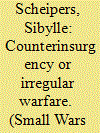

|
|
|
|
|
| Publication |
2014.
|
| Summary/Abstract |
This article argues that the history of irregular warfare provides a valuable analytical and critical perspective for the study of counterinsurgency campaigns and counterinsurgency doctrine. A focus on the history of irregular warfare highlights the close relationship between warfare in Europe and in the colonies. Moreover, it enables us to identify more exactly the intersection of multiple factors that lead to an escalation of violence in small wars. Finally, it also sheds light on the lack of strategic reflection on the use of irregular auxiliaries that is characteristic for many counterinsurgency campaigns.
|
|
|
|
|
|
|
|
|
|
|
|
|
|
|
|
| 14 |
ID:
073195
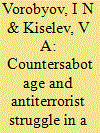

|
|
|
| 15 |
ID:
132463
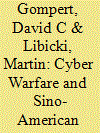

|
|
|
|
|
| Publication |
2014.
|
| Summary/Abstract |
China and the US both recognise that an armed conflict between them would include cyber warfare. But there is a curious and risky failure to connect the tactical military advantages of cyber attacks with the strategic hazards.
|
|
|
|
|
|
|
|
|
|
|
|
|
|
|
|
| 16 |
ID:
192063
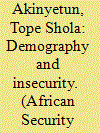

|
|
|
|
|
| Summary/Abstract |
Insecurity is a prominent phenomenon that threatens the peace and development of Africa in general and particularly, the Lake Chad Basin [LCB]. One of the factors driving the menace is the phenomenon of youth bulge. This article argues that young people with poor economic prospects are liable to be recruited for violence. Situated within the grievance model, the article shows how youth make up the larger percentage of protesting, violent and armed groups in the region and presents evidence of how grievance against deprivation moves demography to exacerbate insecurity. The article adopts a qualitative approach and relies on secondary data sourced from briefs, government reports, peer-reviewed journal articles and internet sources. The findings show that the endless supply of children and young people in the LCB is a major factor driving insecurity. By examining the phenomenon of Almajiri, child soldiers and youth radicalisation as enablers of conflict and insecurity in the LCB, the article concludes that population explosion amid a lack of resources leads to grievance and fuels insecurity. This is significant given the paucity of literature on the incidence of demography and insurgency in the LCB; which has become a theatre of insecurity in Africa.
|
|
|
|
|
|
|
|
|
|
|
|
|
|
|
|
| 17 |
ID:
128869
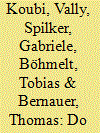

|
|
|
|
|
| Publication |
2014.
|
| Summary/Abstract |
This article reviews the existing theoretical arguments and empirical findings linking renewable and non-renewable natural resources to the onset, intensity, and duration of intrastate as well as interstate armed conflict. Renewable resources are supposedly connected to conflict via scarcity, while non-renewable resources are hypothesized to lead to conflict via resource abundance. Based upon our analysis of these two streams in the literature, it turns out that the empirical support for the resource scarcity argument is rather weak. However, the authors obtain some evidence that resource abundance is likely to be associated with conflict. The article concludes that further research should generate improved data on low-intensity forms of conflict as well as resource scarcity and abundance at subnational and international levels, and use more homogenous empirical designs to analyze these data. Such analyses should pay particular attention to interactive effects and endogeneity issues in the resource-conflict relationship.
|
|
|
|
|
|
|
|
|
|
|
|
|
|
|
|
| 18 |
ID:
143656
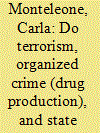

|
|
|
|
|
| Summary/Abstract |
In 2014, the UN Security Council emphasized the dangers of terrorism, criminal activity (especially drug production and trafficking), and state weakness in conflict areas. However, neither policy debates nor scholarly analyses have focussed on the potential impact of these elements on conflict dynamics and characteristics, and the investigated partial relationships have led to inconclusive results. This article explores the presence in armed conflicts of terrorist groups among fighting parties, major drug production (indicating the presence of activities typical of criminal organizations), and state failure in the period 1990–2011. Focussing on intrastate conflicts, this article highlights that, while when they are isolated their impact on armed conflicts is limited, when the three factors are simultaneously present, the interactions among them create a sort of threshold effect capable of affecting conflict characteristics and, in particular, conflict duration and incompatibility.
|
|
|
|
|
|
|
|
|
|
|
|
|
|
|
|
| 19 |
ID:
167402
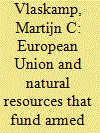

|
|
|
|
|
| Summary/Abstract |
Natural resources can be an important source of funding for warring parties in armed conflicts. Curbing the trade in these so-called conflict resources is, therefore, part of the European Union’s conflict management policies. The article explores the EU’s policies in this field and asks, specifically, why the EU is using supply chain due-diligence measures to achieve this goal. The author argues that they are the response to enforcement problems of most existing multilateral and unilateral sanction regimes because of state weakness in the targeted regions. This approach results from a broader idea from the EU that transparency can improve resource governance and, therefore, safeguard both its political and economic interests in conflict zones, such as the eastern Democratic Republic of the Congo. However, when the issue becomes specific—as in the EU Conflict Minerals Regulation—translating this idea into concrete policies becomes more contentious as the EU institutions set different priorities for the final policy design.
|
|
|
|
|
|
|
|
|
|
|
|
|
|
|
|
| 20 |
ID:
170942
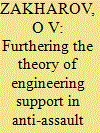

|
|
|
|
|
| Summary/Abstract |
This paper substantiates the role and place of engineering support of anti-assault defense within the general system of military knowledge, and suggests specifying a number of concepts and provisions related to this area of military art
|
|
|
|
|
|
|
|
|
|
|
|
|
|
|
|
|
|
|
|
|